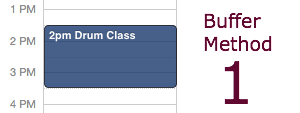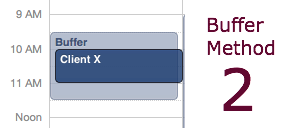Scenario: At the end of the day, you’re frustrated and wondering “What happened?? You had all of your appointments carefully entered on the calendar, there was plenty of “white space” for the other things you wanted to get done and none of them happened! Where’d all the time go?”
What’s typically happening—besides dealing with high-priority unexpecteds popping on the scene—is that when scheduling, you think about the core part of a commitment but then don’t account for the time and energy that goes to the extras: prep, transition, travel, process and/or recovery.
Thus you underestimate the amount of time to enter in the calendar. Whether you schedule it or not, the extras happen and negatively impact the rest of the day. Bummer.
Learning to manage your energy helps you to do the right stuff at the right time, design your week to support sustainable work flow, and helps you end more days feeling satisfied with progress and happy to not be exhausted.
One easy energy management remedy to prevent end-of-the-day frustration: Buffering!
Relying on memory of past experiences and observed patterns, you anticipate the additional space needed for the extras. After you think it through, you’ll literally add a block of time to your calendar to buffer the activity.
Following are:
- 5 triggers to watch for.
- 3 ways that I add buffer time to my calendar with screenshots.
1. Prep
While it may be a 5-minute drive to your next appointment, how long does it take to check the bag, put on lipstick, locate keys, go back to the kitchen to find sunglasses, get out the house, walk to the car, back out, get up the driveway and get on the road? It adds up.
Just for fun, you can use the stopwatch on your smart phone to see how long it typically takes to get to Minute 1 of the actual drive time. Or, just add another 5-10 minutes as a buffer.
Keep in mind that typically, the higher priority the appointment is, the more things to remember and greater consequence for being late so add even more time.
2. Transition
I won’t get into the neuroscience of thought-process here but dropping into an activity, especially those that require focus or creativity, takes time and energy.
If you know that writing a blog post takes you an hour, then buffer the appointment by, say 15-20 minutes. This way, you’ll give yourself adequate time for the real writing.
On the other end, these are often the activities that you have a hard time extracting yourself from. When you’re deep in it, it’s tough to pull your attention away and shift to the next thing in your schedule.
If this is one of your patterns, then take note of which activities require drop-in and/or transition time and see if you can get a sense for how long you need to add as a buffer.
If you use an online scheduler, adding buffer time prevents people from being able to schedule back to back (if you prefer this). Personally, I prefer at least half an hour between client appointments. My scheduler won’t do this automatically so adding a buffer serves this purpose as well.
3. Travel
I won’t get into the physics of time and space here but getting from point A to point B takes time and energy, even when it isn’t on your calendar.
Adding travel-buffer time in your calendar keeps you realistic when considering how much “free” time is represented by the white space of unscheduled time.
4. Post-meeting processing
Some committee meetings and client meetings trigger a series of actions that are best dealt with while fresh. Trying to piece together notes from two weeks ago is a drag.
Add a post-meeting buffer to these appointments and then process those notes, ToDos, and reference info into your system straight away for a hassle-free existence.
This is also helpful for client work that is also part of developing a new offering. After an appointment, you’re likely to have ideas galore coursing through your mind. Now, while it’s fresh, is a great time to incorporate those thoughts into your development notes.
5. Recovery
Some appointments take a huge toll on your energy. A three hour intensive client session for example, may leave you feeling drained and exhausted.
Add recovery buffer time in your schedule to both
1) remind yourself not to schedule something else right afterward, and
2) remind yourself to actually allow for recovery.
I.e. Refrain from pushing into busywork. (Maybe schedule a date with yourself to enjoy an afternoon tea and read a fun book.)
You can also lump re-entry space here. If you go out of town and know that you’ve got a pile of catch-up waiting for you, add a buffer on Monday to keep that time free. Anticipate by giving yourself the gift of space.
Those are the five main areas to review for adding buffer time to your schedule.
3 methods to buffer up
- Add the buffer to the appointment itself. Be sure to add the actual appointment time to the subject line. I tend to use this method for the non-negotiable buffers, like travel time.

- Add a separate calendar item that will float before/after the actual appointment. Sometimes I call it “Buffer” and sometimes, as an added self-care reminder, I call it, “My Time.”With the additional item called “Buffer”, it’s easier to scan my calendar and anticipate my energy flow for the day.

- Include transition time in the appointment. This is most relevant for your appointments scheduled with yourself. For ex. If you want a good hour session dedicated to writing, schedule 75 minutes to allow for 15 minutes to drop in.
The best time to add buffers to your schedule is when you add the appointment. If this doesn’t happen, then your weekly Review and Planning (RAP) Session is a perfect time. (The RAP Session is the weekly process I suggest you do to review your schedule and plan out your ToDos (in the context of your energy availability.)
Show up with your best self!
Bring awareness to the potential hot spot appointments in your schedule and deal with them pro-actively. You’ll feel more calm, confident and prepared. You won’t be as reactive and rushed.
You’ll save energy by reducing recovery time from frequently getting thrown off track. You’ll also have a much more realistic sense of what the white space in your schedule represents.
Add buffers to your schedule. It’s good for you and tastes better than wheat germ.
Call to action
Add buffer time to the potential hot spot appointments in your schedule this and next week.

